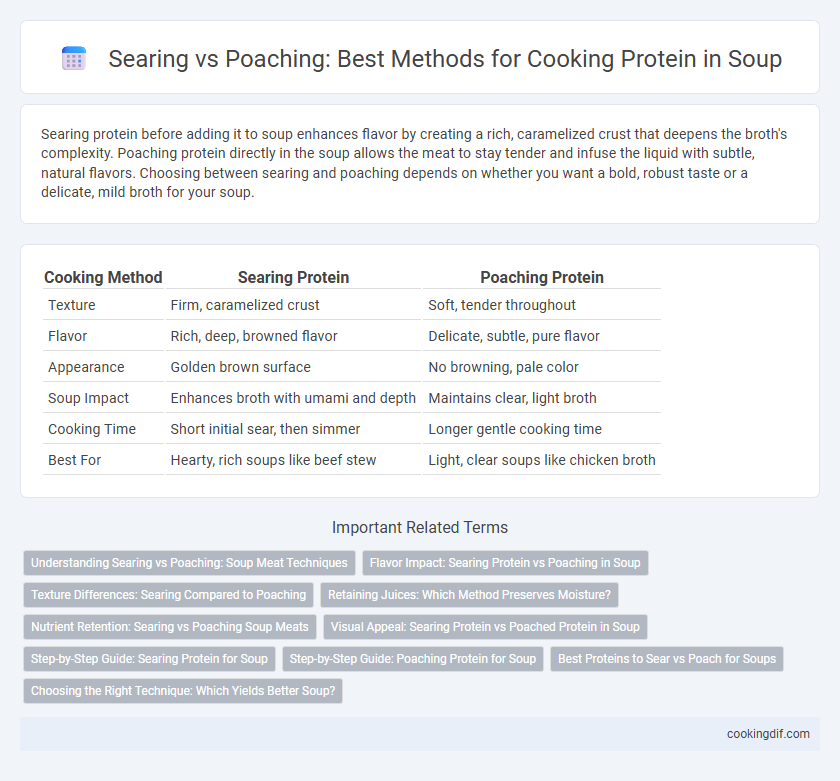Searing protein before adding it to soup enhances flavor by creating a rich, caramelized crust that deepens the broth's complexity. Poaching protein directly in the soup allows the meat to stay tender and infuse the liquid with subtle, natural flavors. Choosing between searing and poaching depends on whether you want a bold, robust taste or a delicate, mild broth for your soup.
Table of Comparison
| Cooking Method | Searing Protein | Poaching Protein |
|---|---|---|
| Texture | Firm, caramelized crust | Soft, tender throughout |
| Flavor | Rich, deep, browned flavor | Delicate, subtle, pure flavor |
| Appearance | Golden brown surface | No browning, pale color |
| Soup Impact | Enhances broth with umami and depth | Maintains clear, light broth |
| Cooking Time | Short initial sear, then simmer | Longer gentle cooking time |
| Best For | Hearty, rich soups like beef stew | Light, clear soups like chicken broth |
Understanding Searing vs Poaching: Soup Meat Techniques
Searing protein for soup meat develops a rich, caramelized crust that intensifies flavor through the Maillard reaction, enhancing the overall depth of the broth. Poaching protein involves gently cooking meat in simmering liquid, preserving tenderness and moisture while imparting a delicate, clean taste to the soup. Choosing searing or poaching impacts texture and flavor profiles, with searing ideal for robust, hearty soups and poaching best for light, clear broths.
Flavor Impact: Searing Protein vs Poaching in Soup
Searing protein before adding it to soup enhances flavor through the Maillard reaction, creating rich, caramelized notes that deepen the broth's complexity. Poaching protein maintains a delicate, mild taste and tender texture since it cooks gently in liquid without browning. Choosing searing over poaching intensifies savory depth, while poaching preserves subtle freshness in the soup's overall flavor profile.
Texture Differences: Searing Compared to Poaching
Searing protein for soup develops a flavorful crust and firmer texture by caramelizing the surface, enhancing the overall mouthfeel and adding complexity to the broth. Poaching protein, in contrast, results in a tender, delicate texture as it cooks gently in liquid, preserving moisture but offering a subtler taste. Choosing searing intensifies texture contrast and depth, while poaching prioritizes softness and purity of flavor in soup meat.
Retaining Juices: Which Method Preserves Moisture?
Searing protein before adding it to soup creates a flavorful crust that helps lock in juices, enhancing moisture retention during cooking. Poaching, a gentle, low-temperature method, minimizes moisture loss by cooking protein in liquid, resulting in tender, juicy meat without the risk of drying out. For soups requiring richly flavored, moist meat, searing followed by simmering often provides the best balance between taste and juiciness.
Nutrient Retention: Searing vs Poaching Soup Meats
Poaching soup meats preserves more water-soluble vitamins like B-complex and vitamin C compared to searing, which involves high heat that can degrade heat-sensitive nutrients. Searing creates a flavorful crust through the Maillard reaction but may reduce nutrient retention by causing some nutrient loss via surface charring. For optimal nutrient preservation in soups, poaching helps retain essential minerals and amino acids better than searing.
Visual Appeal: Searing Protein vs Poached Protein in Soup
Searing protein before adding it to soup creates a rich, caramelized crust that enhances the visual appeal with deep, golden-brown hues, contrasting attractively against the broth. Poached protein, immersed gently in liquid, retains a pale, uniform color that blends seamlessly into the soup but lacks the textural complexity and color variation of seared meat. The choice between searing and poaching directly impacts the soup's aesthetic by defining the color contrast and perceived depth of flavor.
Step-by-Step Guide: Searing Protein for Soup
Searing protein for soup involves heating the meat on high heat until a brown crust forms, which enhances the flavor through the Maillard reaction and locks in juices. Begin by patting the meat dry, seasoning it, and placing it in a hot pan with a small amount of oil; cook each side for 2-3 minutes until browned. This method creates a richer, more complex broth compared to poaching, which gently cooks protein in liquid without browning.
Step-by-Step Guide: Poaching Protein for Soup
Poaching protein for soup involves gently cooking the meat in simmering liquid at temperatures between 160degF to 180degF to retain moisture and tenderness. Begin by immersing the protein fully in broth or water seasoned with herbs and aromatics, maintaining a low simmer without boiling to prevent toughening the texture. This method enhances flavor infusion and yields a delicate, juicy protein ideal for clear or light soups.
Best Proteins to Sear vs Poach for Soups
Beef chuck, lamb shoulder, and pork shoulder are ideal for searing before adding to soups, as high heat caramelizes their exterior, enhancing rich, savory flavors and creating a deep, complex broth. White meats like chicken breast, fish fillets, and delicate seafood are best suited for poaching, which gently cooks the protein, preserving moisture and tenderness without toughening fibers. Searing tough, fatty cuts maximizes Maillard reactions, while poaching maintains the integrity of lean, mild proteins for clear, delicate soup textures.
Choosing the Right Technique: Which Yields Better Soup?
Searing protein for soup locks in flavor by caramelizing the surface, creating a rich, umami depth that enhances broth complexity. Poaching protein offers a gentler cooking method that preserves tenderness and leaches subtle flavors into the soup, resulting in a cleaner, lighter taste. For hearty, robust soups, searing is ideal, while poaching suits delicate soups requiring subtle, refined flavors.
Searing protein vs Poaching protein for soup meat Infographic

 cookingdif.com
cookingdif.com